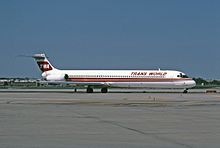One-Two-Go Airlines Flight 269
On 16 September 2007, about 15:41 ICT, the McDonnell Douglas MD-82 operating the flight crashed into an embankment beside runway 27 at Phuket International Airport (HKT) bursting into flames upon impact during an attempted go-around after an aborted landing, killing 90 of the 130 people on board (including one person who died of burn injuries several days after the crash).[4]: 2 The flight crew consisted of Captain Arief Mulyadi (57), an Indonesian national and the Chief Pilot of One-Two-Go Airlines, and a former Indonesian Air Force pilot; and First Officer Montri Kamolrattanachai (30), a Thai national who had recently completed his flight training with One-Two-Go's ab initio program.Air traffic control (ATC) requested Flight 269 acknowledge the weather information provided and re-state intentions.The aircraft continued to descend and fell below 50 feet (15 m) ATL, causing the autothrottle to reduce engine thrust to idle.[9] Various embassies and ministries in Bangkok confirmed the following numbers:[10] According to Vutichai Singhamany, a safety director at Thailand's Department of Civil Aviation and the lead crash investigator, the pilot had deployed the landing gear on approach to Phuket airport runway 27, but had retracted it when attempting a go-around.Singhamany added that the wheels had not touched the runway and that the accident had happened moments after the pilot raised the nose of the aircraft to abort the landing.[23][24] At the time of the crash, speculation rested on the pilot's decision to land in poor weather conditions and on the airport's wind shear detection system, which was not operational that day.[1] The cause of the crash was found to be due to a combination of human performance and operational issues, including: Human Performance:[1] Operational:[1] The NTSB noted that, "although the weather deteriorated in the later stages of this flight, wind shear was not a factor in this accident" and "It is understood that during the accident sequence, the pilots were potentially distracted by the weather conditions; however, that distraction should not cause a loss of control of the airplane."[1] The NTSB stated that the possible causes of this accident, consistent with available evidence, are that: The crew did not properly perform the go-around and failed to activate the TO/GA switch.The airplane's flight management system automatically retarded the throttles, since the approach slat/flap logic for landing was met.
go-aroundPhuket International AirportMcDonnell Douglas MD-82One-Two-Go AirlinesRegistrationDon Mueang International AirportAircraft Accident Investigation CommitteeMinistry of TransportNational Transportation Safety BoardEuropean UnionOrient Thai Airlinesab initiowind shearfinal approachcumulonimbus cloudsAir traffic controlinstrument landing systemautothrottleGo aroundTrans World Airlines (TWA)Trans World AirlinesAmerican AirlinesAlexander DownerRadio FardaIranianEsteghlal F.C.Iran national under-23 football teamyouth playerBritish embassyFrench foreign ministryIreland foreign ministrySwedish foreign ministryUS embassyDepartment of Civil Aviationlanding gearflight data recordercrew resource managementtakeoff/go-around switchair operator's certificateModernine TVThai PBSGround effect (aerodynamics)Ground proximity warning systemList of accidents and incidents involving airliners by locationLow level windshear alert systemNEXRADRunway safety areaThai Airways International Flight 261TAM Airlines Flight 3054China Airlines Flight 140Jeju Air Flight 2216Indonesian nameThai nameFlight Safety FoundationLauda Air Flight 004Channel NewsAsiaBBC NewsCanadian Broadcasting CorporationHaAretzThe Sunday TimesThe Bangkok PostAssociated PressWayback MachineMcDonnell Douglas-80/81/82/83/87/88MD-95 / Boeing 717West Coast Airlines Flight 956TWA Flight 553Ozark Air Lines Flight 965Ozark Air Lines Flight 982Viasa Flight 742Allegheny Airlines Flight 8531970 Dominicana air disasterEastern Air Lines Shuttle Flight 1320ALM Flight 980Southern Airways Flight 932Hughes Airwest Flight 7061972 Turkish Airlines Adana crashJAT Flight 367EgyptAir Flight 763Delta Air Lines Flight 9570Scandinavian Airlines System Flight 130Southern Airways Flight 491972 Chicago–O'Hare runway collision1973 Nantes mid-air collisionAeroméxico Flight 229Delta Air Lines Flight 723Eastern Air Lines Flight 212Avensa Flight 358Inex-Adria Aviopromet Flight 4501976 Zagreb mid-air collisionSouthern Airways Flight 242Air Canada Flight 189TWA Flight 541Alitalia Flight 4128Itavia Flight 870Garuda Indonesian Airways Flight 206Aeroméxico Flight 230Aeroméxico Flight 110Avensa Flight 007Air Canada Flight 7971983 Madrid runway disasterOzark Air Lines Flight 650Midwest Express Airlines Flight 105Aeroméxico Flight 498Garuda Indonesia Flight 035Continental Airlines Flight 1713Evergreen International Airlines Flight 17Alitalia Flight 4041990 Wayne County Airport runway collisionRyan International Airlines Flight 590Aeropostal Alas de Venezuela Flight 109Japan Air System Flight 451USAir Flight 1016Intercontinental de Aviación Flight 256ValuJet Flight 592Austral Líneas Aéreas Flight 2553Cebu Pacific Flight 387TAESA Flight 725Sosoliso Airlines Flight 11452006 Mexico drug bustHewa Bora Airways Flight 122Inex-Adria Aviopromet Flight 1308Northwest Airlines Flight 255Austral Líneas Aéreas Flight 046Scandinavian Airlines System Flight 751